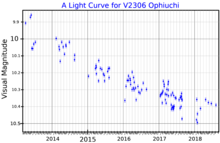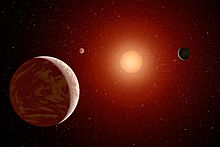Wolf 1061
| Observation data EpochJ2000EquinoxJ2000 | |
|---|---|
| Constellation | Ophiuchus |
| Right ascension | 16h30m18.0584s[1] |
| Declination | −12° 39′ 45.325″[1] |
| Apparent magnitude(V) | 10.07[2](10.05 - 10.10)[3] |
| Characteristics | |
| Spectral type | M3.5V[4] |
| U−Bcolor index | +1.20[5] |
| B−Vcolor index | +1.57[2] |
| Variable type | BY Draconis[3] |
| Astrometry | |
| Radial velocity(Rv) | −21.22[6]km/s |
| Proper motion(μ) | RA:−94.212[1]mas/yr Dec.:1,183.679[1]mas/yr |
| Parallax(π) | 232.1390 ± 0.0268mas[7] |
| Distance | 14.050 ± 0.002ly (4.3078 ± 0.0005pc) |
| Absolute magnitude(MV) | 11.87[4] |
| Details | |
| Mass | 0.304±0.007[8]M☉ |
| Radius | 0.319±0.007[8]R☉ |
| Luminosity (bolometric) | 0.0110±0.0001[8]L☉ |
| Luminosity (visual, LV) | 0.0015L☉ |
| Temperature | 3,307+38 −36[8]K |
| Metallicity[Fe/H] | −0.09±0.09[4]dex |
| Rotation | 95 d[4] |
| Other designations | |
| Database references | |
| SIMBAD | data |
Wolf 1061(also known asHIP80824 and V2306 Ophiuchi) is anM-classred dwarfstar located about 14.1light-yearsaway in the constellationOphiuchus.It is the36th-closest-knownstar system to theSunand has a relatively highproper motionof 1.2seconds of arcper year. Wolf 1061 does not have any unusualspectroscopicfeatures.[9]
The star
[edit]
Wolf 1061 was first cataloged in 1919 by German astronomerMax Wolfwhen he published a list of dim stars that had high proper motions. Wolf 1061's name originates from this list.[11]A seven years study found no evidence of photometric transits and confirms the radial velocity signals are not due to stellar activity. The habitable zone estimate for the system lies between approximately 0.1 and 0.2 AU from the star.
Planetary system
[edit]
In December 2015, a team of astronomers from theUniversity of New South Walesannounced the discovery of threeplanetsorbiting Wolf 1061. The planets were detected by analyzing 10 years of observations of the Wolf 1061 system by theHARPSspectrograph atLa Silla ObservatoryinChile.The team used archiveradial velocitymeasurements of the star's spectrum in the HARPS data and, along with 8 years ofphotometryfrom theAll Sky Automated Survey,discovered two definite planets with orbital periods of around 4.9 and 17.9 days and a very likely third with a period of 67.3 days.[9]
All three planets have masses low enough that they are likely to berocky planetssimilar to theinner planetsof theSolar Systemalthough their actual sizes and densities are currently unknown. However, this information could be determined if the planets happen totransitin front of Wolf 1061 when viewed from Earth. Because all three planets orbit close to the star and have short orbital periods, there is a chance that this will occur. The University of New South Wales team estimated the chances of a transit at around 14% for planet b, 6% for planet c, and 3% for planet d.[9]
One of the planets,Wolf 1061c,is asuper-Earthlocated near the inner edge of the star'shabitable zone,which conservatively extends from 0.11 to 0.21 AU, or at most from 0.09 to 0.23 AU.[2]It is one of the closest known potentially habitable planets to Earth afterProxima b,Ross 128 b,andLuyten b.[13][14]The next planet out, Wolf 1061 d, could be marginally habitable depending on its atmosphere's composition as it orbits just beyond the habitable zone.[9]
In March 2017, another team of astronomers re-analyzed the system using the HARPS spectrograph. They found planets b and c to be quite similar to their originally reported parameters, but found that planet d was more massive and in a larger, more eccentric orbit. The team was also able to find updated parameters for the host star. Their results showed that Wolf 1061 c is slightly smaller, yet closer to the inner edge of the habitable zone.[4]
| Companion (in order from star) |
Mass | Semimajor axis (AU) |
Orbital period (days) |
Eccentricity | Inclination | Radius |
|---|---|---|---|---|---|---|
| b | ≥1.91 ± 0.25M🜨 | 0.0375 ± 0.0012 | 4.8869 ± 0.0005 | 0.15+0.13 −0.10 |
— | 1.2(estimated)R🜨 |
| c | ≥3.41+0.43 −0.41M🜨 |
0.0890 ± 0.003 | 17.8719 ± 0.0059 | 0.11+0.10 −0.07 |
— | 1.45(estimated)R🜨 |
| d | ≥7.7+1.12 −1.06M🜨 |
0.470 ± 0.016 | 217.21+0.55 −0.52 |
0.55+0.08 −0.09 |
— | 2.2(estimated)R🜨 |
See also
[edit]References
[edit]- ^abcdGaia Collaboration; Brown, A. G. A; Vallenari, A; Prusti, T; De Bruijne, J. H. J; Mignard, F; Drimmel, R; Babusiaux, C; Bailer-Jones, C. A. L; et al. (2016). "Gaia Data Release 1. Summary of the astrometric, photometric, and survey properties".Astronomy & Astrophysics.595:A2.arXiv:1609.04172.Bibcode:2016A&A...595A...2G.doi:10.1051/0004-6361/201629512.S2CID1828208.
- ^abcKane, Stephen R.; et al. (February 2017), "Characterization of the Wolf 1061 Planetary System",The Astrophysical Journal,835(2): 9,arXiv:1612.09324,Bibcode:2017ApJ...835..200K,doi:10.3847/1538-4357/835/2/200,S2CID30738573,200.
- ^abSamus, N. N.; Durlevich, O. V.; et al. (2009). "VizieR Online Data Catalog: General Catalogue of Variable Stars (Samus+ 2007-2013)".VizieR On-line Data Catalog: B/GCVS. Originally Published in: 2009yCat....102025S.1.Bibcode:2009yCat....102025S.
- ^abcdefAstudillo-Defru, Nicola; Forveille, Thierry; Bonfils, Xavier; Ségransan, Damien; Bouchy, François; Delfosse, Xavier; et al. (2017)."The HARPS search for southern extra-solar planets. XLI. A dozen planets around the M dwarfs GJ 3138, GJ 3323, GJ 273, GJ 628, and GJ 3293".Astronomy and Astrophysics.602.A88.arXiv:1703.05386.Bibcode:2017A&A...602A..88A.doi:10.1051/0004-6361/201630153.S2CID119418595.
- ^Mermilliod, J.-C. (1986), "Compilation of Eggen's UBV data, transformed to UBV (unpublished)",Catalogue of Eggen's UBV Data. SIMBAD,Bibcode:1986EgUBV........0M.
- ^Nidever, David L.; et al. (August 2002), "Radial Velocities for 889 Late-Type Stars",The Astrophysical Journal Supplement Series,141(2): 503–522,arXiv:astro-ph/0112477,Bibcode:2002ApJS..141..503N,doi:10.1086/340570,S2CID51814894.
- ^Brown, A. G. A.;et al. (Gaia collaboration) (2021)."GaiaEarly Data Release 3: Summary of the contents and survey properties ".Astronomy & Astrophysics.649:A1.arXiv:2012.01533.Bibcode:2021A&A...649A...1G.doi:10.1051/0004-6361/202039657.S2CID227254300.(Erratum:doi:10.1051/0004-6361/202039657e).Gaia EDR3 record for this sourceatVizieR.
- ^abcdPineda, J. Sebastian; et al. (September 2021)."The M-dwarf Ultraviolet Spectroscopic Sample. I. Determining Stellar Parameters for Field Stars".The Astrophysical Journal.918(1): 23.arXiv:2106.07656.Bibcode:2021ApJ...918...40P.doi:10.3847/1538-4357/ac0aea.S2CID235435757.40.
- ^abcdeWright, D. J; Wittenmyer, R. A; Tinney, C. G; Bentley, J. S; Zhao, Jinglin (2016)."Three Planets Orbiting Wolf 1061".The Astrophysical Journal Letters.817(2): L20.arXiv:1512.05154.Bibcode:2016ApJ...817L..20W.doi:10.3847/2041-8205/817/2/L20.S2CID52320394.
- ^"ASAS-SN Variable Stars Database".ASAS-SN Variable Stars Database.ASAS-SN.Retrieved6 January2022.
- ^Wolf, M. (June 1919). "Katalog von 1053 staerker bewegten Fixsternen (Catalog of 1053 moving fixed stars) ".Veroeffentlichungen der Badischen Sternwarte zu Heidelberg(in German).7(10): 195–219.Bibcode:1919VeHei...7..195W.
- ^"Astronomers discover closest potentially habitable planet: Wolf 1061c".ScienceAlert.com.17 December 2015.Retrieved17 December2015.
- ^Davison, Cassy L.; White, Russel J.; Henry, Todd J.; Riedel, Adric R.; Jao, Wei-Chun; Bailey III, John I.; Quinn, Samuel N.; Justin R., Cantrell; John P., Subasavage; Jen G., Winters (2015). "A 3D Search for Companions to 12 Nearby M-Dwarfs".The Astronomical Journal.149(3): 106.arXiv:1501.05012.Bibcode:2015AJ....149..106D.doi:10.1088/0004-6256/149/3/106.S2CID9719725.
- ^Stuart Gary (17 December 2015)."Potentially habitable super-Earth discovered orbiting star 14 light years from Earth".ABC News (Australia).


